14 Autumn garden chores for a healthy garden
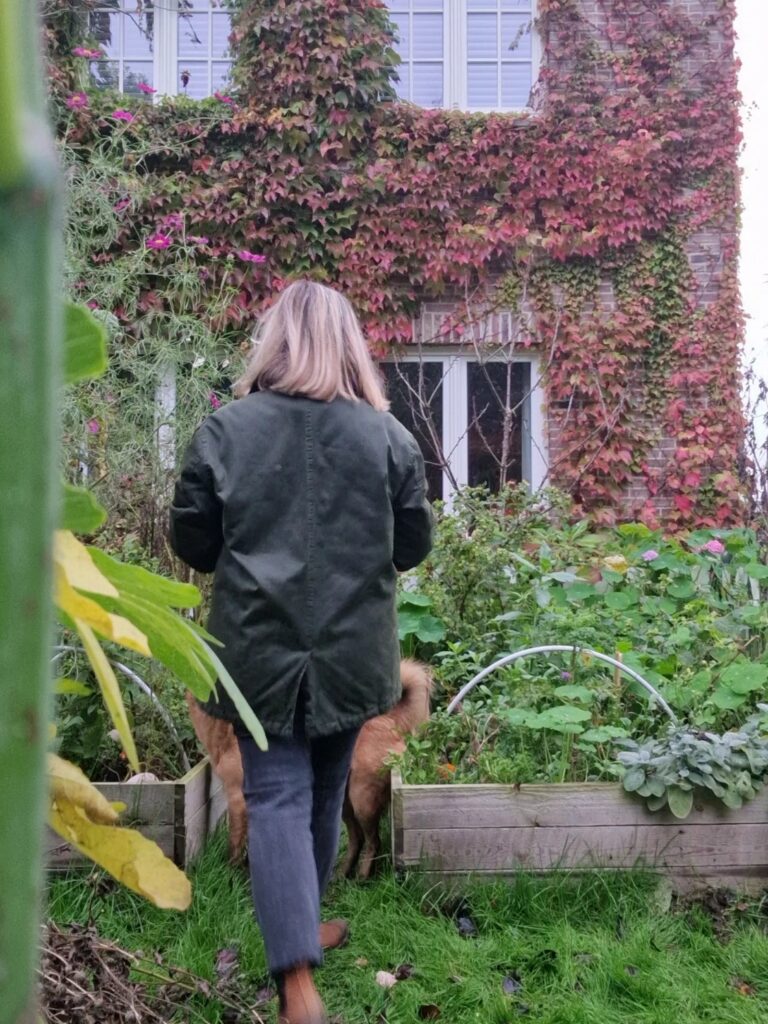
A rookie mistake would be to think that gardening only happens during the growing season (Spring and Summer). In fact, if you want a beautiful, lush and healthy garden, you need to know that most of the ‘behind the scenes’ work is what actually makes your garden thrive during the growing season.
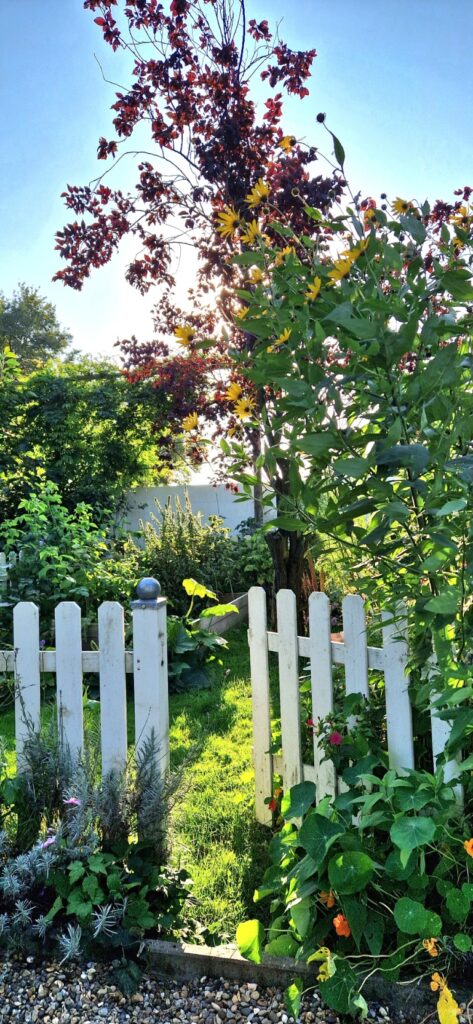
The ‘behind the scenes’ of gardening
At first glance, these ‘behind the scenes’ chores might look like anything but pleasant. However, it all depends on how you look at it. Mindset is important in anything that we do in life, including gardening. For me, gardening in Autumn is like putting the garden to sleep, gently caring for it and tucking it in before the hibernation season of Winter kicks in.
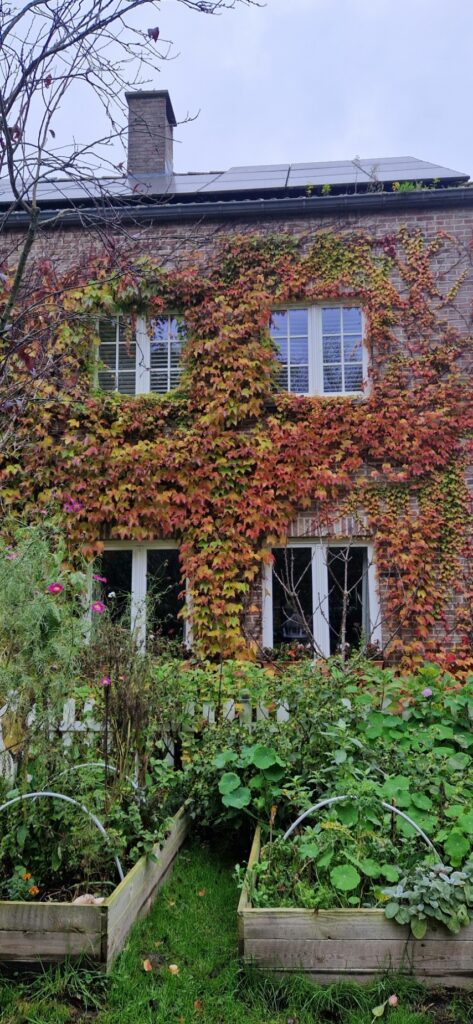
A healthy garden
It goes without saying that a healthy garden is a garden that is biodiverse and ecologically friendly. Biodiverse means that there is a diversity of plants, herbs, shrubs, trees, flowers… growing in your garden. The more diversity there is, the healthier it will be. This also means a big diversity in animals such as birds and insects but also micro-organisms living in the soil that are invisible to the naked eye.
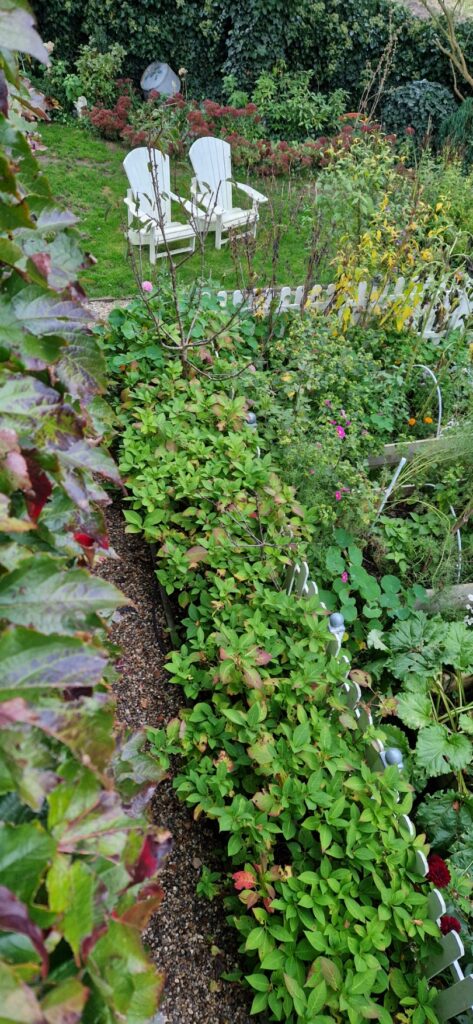
Here are some of the main Autumn garden chores I do every year:
1. Take notes and make an inventory
Start by buying yourself a gardening journal, or maybe you still have an unused journal or notebook that you could use for this. Grab your favorite pen or pencil and make yourself a warm cup of tea.
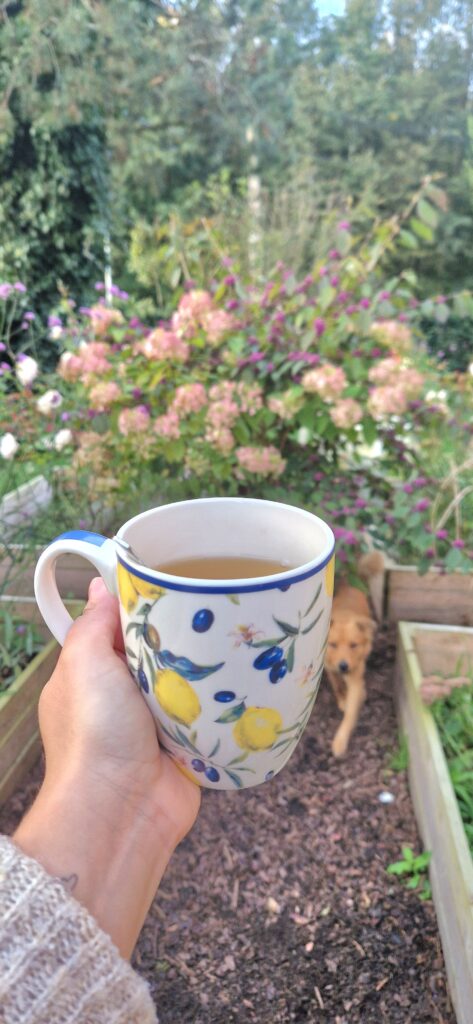
Are you ready?
Then step out into your garden with your journal in your pocket and your cup of tea, keeping your hands warm.
Oh yes, and don’t forget about the dogs! Or your cat(s)! They might have some ideas too.
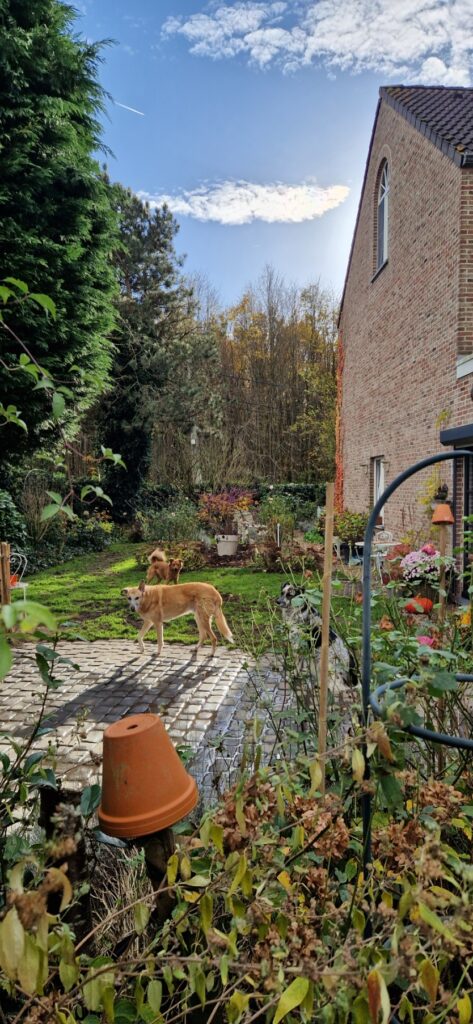
Then start moving through your garden as though you are a visitor. Look carefully with keen and curious eyes and ask yourself the following questions as you move through your garden:
- Which plants thrived this year?
- Which plants died prematurely or never bloomed (if they are the blooming kind of course)?
- Which plants turned into a bit of a bully and pushed out other plants?
- Which areas of the garden need to be revived or updated?
- Which plants would you like to add to your garden and do you have the growing conditions for them (soil, climate, is there enough sun or shade)?
- Which plants do you want to remove from your garden?
- Which plants simply need to be moved to another area of the garden?
- Which perennials need to be divided?
- How’s the quality of the soil?
- Which trees or shrubs need to be cut back or trimmed a bit so they continue to have a beautiful shape?
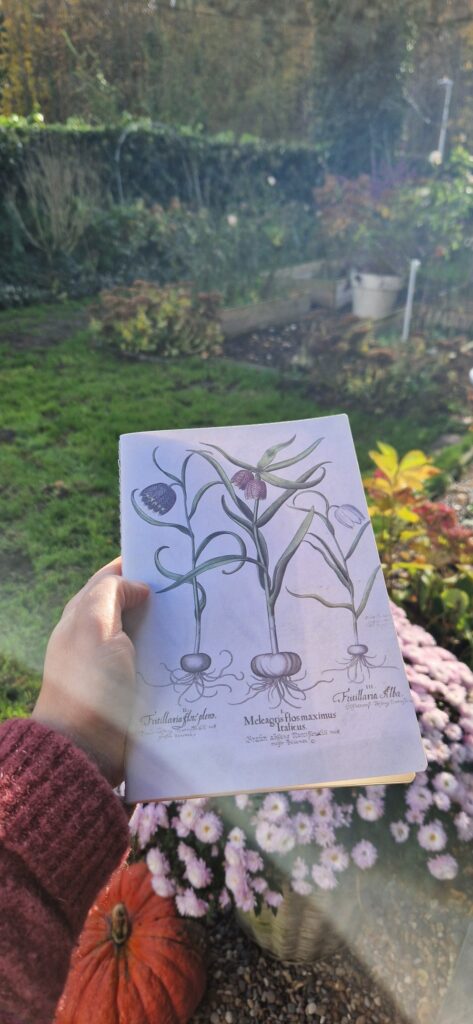
Once you’re done taking your garden tour, start answering these questions in your journal. Don’t worry too much about it, the point is to create some clarity for yourself. Rarely do I have all the answers in one go. I often do multiple garden tours on different days or even throughout the year because there is always something new that pops up in my brain.
I sometimes even leave notes in my garden journal for my future self. For instance, if it’s April and I am loving a particular tulip variety that is growing in the garden I might write a reminder to buy and plant more of that variety in Autumn.
Gardening is an on-going process
The main thing to remember is that gardening is an on-going process, it is never ‘done’. This might freak out some people but to me, it does quite the opposite. I love that it’s an on-going process and that it’s a living and breathing thing that evolves with me as a gardener.
There’s no room for perfectionism here, only fun and creativity.
If there’s one thing that growing a garden will teach you, is that ‘control’ is an illusion. To become a gardener is to learn how to dance with nature. Not to control or oppress it. If you try to do otherwise, you will soon realize that this is a game you will never win. Just relax, have fun.
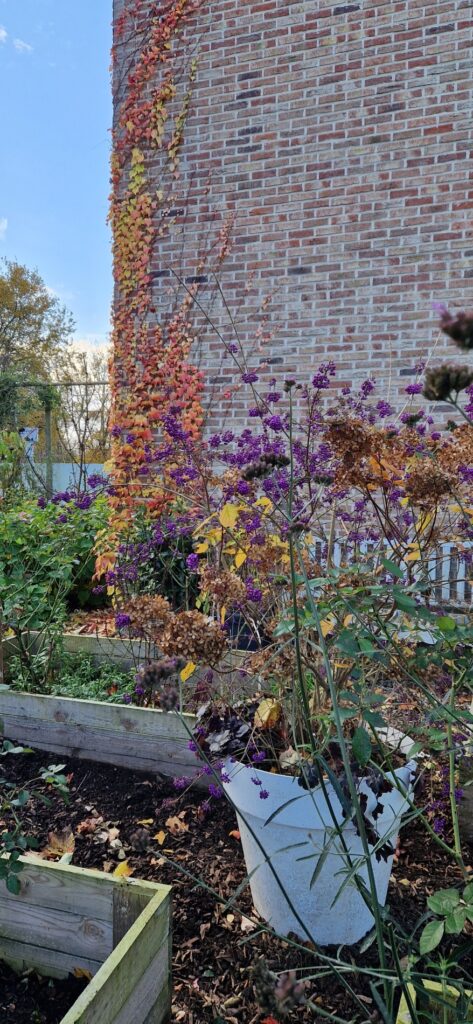
2. Cut back grass one last time
Once the temperatures drop and the days become shorter, grass will stop growing. This is the time to give it one last mow. Do this before it starts freezing.
After cutting it back, give your lawn some lime to prevent the soil from becoming too acidic. In addition, feed it one last time with an organic fertilizer.
3. Tidy up the borders (a bit)
I say ‘a bit’ because I don’t want it to be a sterile garden with everything cut back to the ground. If you cut everything back to the ground, that means that birds, insects and even mammals such as hedgehogs, will not be able to find shelter in your garden for the coming months. Remember that a healthy garden is a garden that is bursting with life.
Also, you don’t want the soil to be bare for months. If you do, if will impoverish the quality of the soil. And remember that it is the quality of your soil that dictates whether or not your garden will thrive during the growing season.
Most of the borders, I only cut back in late Winter. However, as not to overwhelm myself I slowly start cutting things back a bit in Autumn. It’s not the ‘deep clean’ that leaves my borders open and bare. Instead, I remove, divide or replace perennials and cut the dead wood and flowers back.
Also climbing roses that are flapping around, are cut back to a few main stems and I make sure I tie them up to the trellis.
There is one exception which is that I tidy up the raised beds where I grow my Poustinia roses. I remove weeds, plants Spring bulbs and then cover the bulbs with compost and leaves.
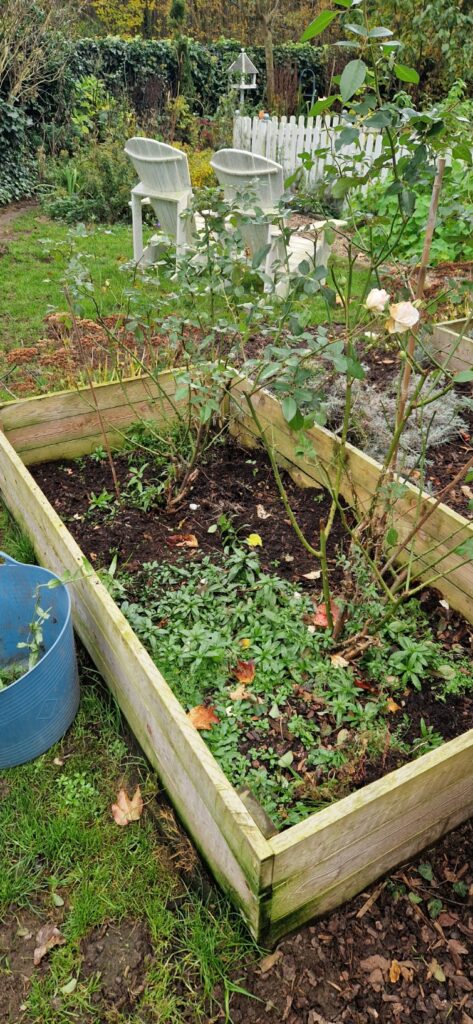
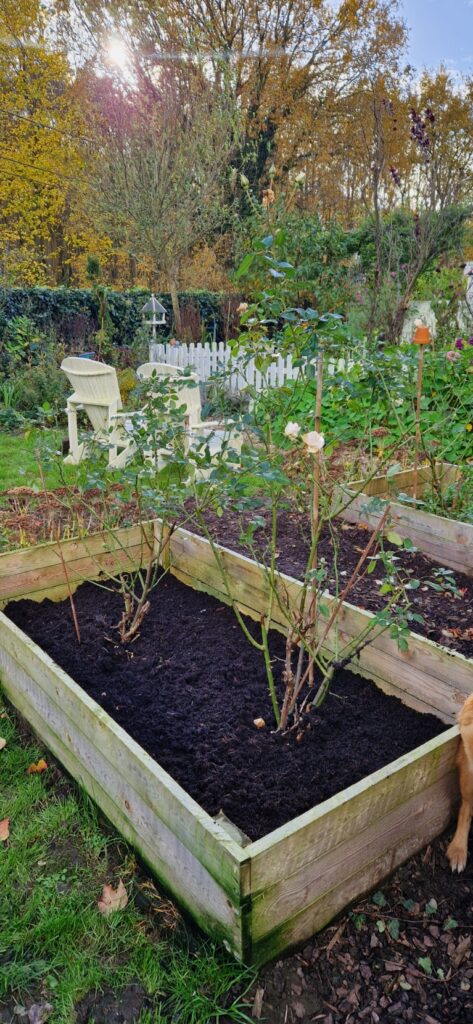
I still need to plant tulip bulbs and cover the soil with leaves.
4. Weed the borders one last time
I know, I know… this is not our favorite garden chore, is it?! However, if you spend some time taking out the weeds now, you’ll have a lot less work weeding during the next growing season.
I promise!
If you leave the weeds in the ground, they will surely start their shenanigans by growing deep and strong roots. Making it even more difficult to efficiently remove them during Spring and Summer.
Go ahead, you can do it! Maybe we should get ourselves a cup of tea first? Or maybe we need something stronger for this? A cappuccino maybe?
5. Plant Spring bulbs
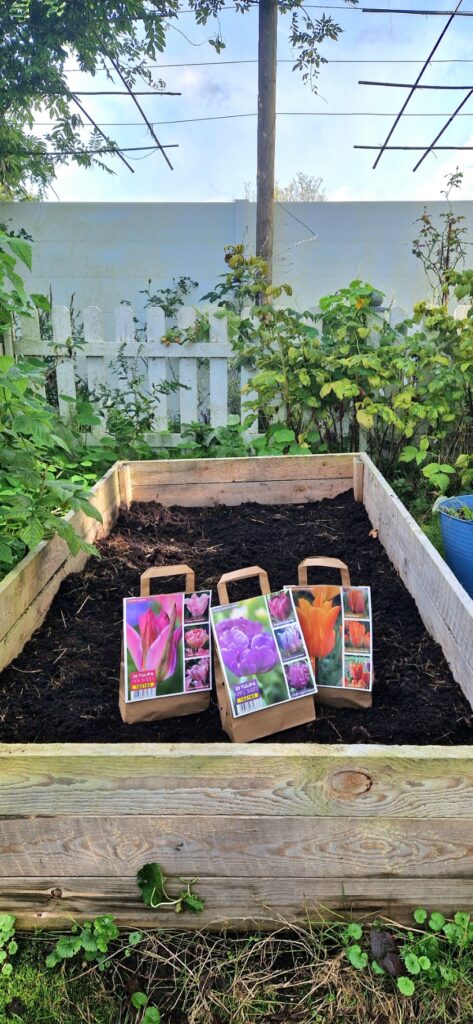
Nothing fills my heart with hope like seeing those first flowers growing in the garden after a long and dark Winter. Think of crocuses, tulips, daffodils, hyacinths… The varieties and colors are infinite.
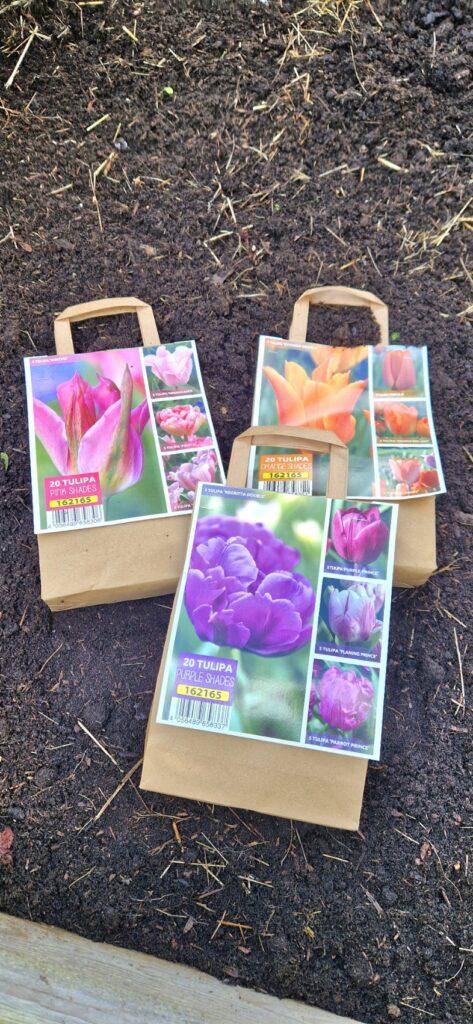
Flower bulbs that start blooming in early Spring should be planted in Autumn. You can start planting them as early as September until the first half of December (although December is already pushing it).
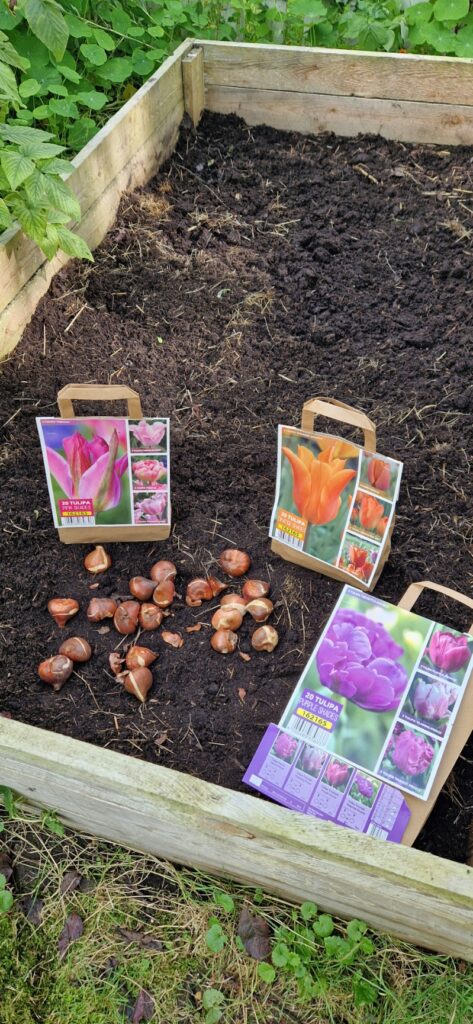
For a beautiful display, I would recommend planting them in groups and mixing up colors.
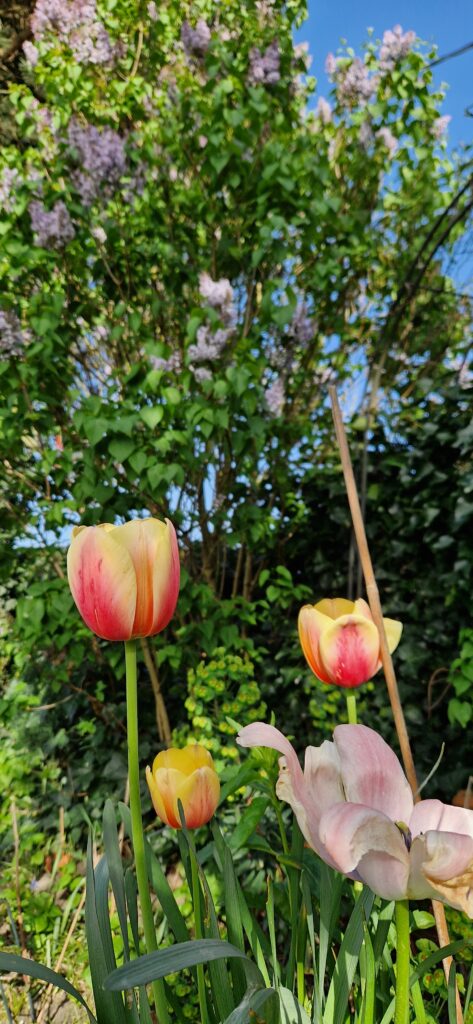
6. Give flower beds and borders extra care
After you’ve tidied up the borders a bit, planted Spring bulbs and shuffled around some perennials, give the soil some good quality lime and organic fertilizer. Then cover the border with compost and leaves.
7. Feed the birds
Garden birds are your friends! Write that down!
Not only are they beautiful to watch, their presence in our gardens insures us that pests are kept under control.
You want to make your garden a safe place for birds where they can find shelter, food and have babies. And who knows, maybe one day, they might help you out with your household chores.
I make feeding stations all around the garden and I make sure I don’t hang food in places where it is too open. Small birds will not come to a feeding station that doesn’t have some trees, shrubs or shelter near it because it would put them at risk for being caught by birds of prey.
Throughout the years, I have discovered that ‘my’ garden birds prefer peanuts. This is because peanuts are nutrient-dense and high in calories. Birds, especially small birds, need lots of calories to maintain their tiny bodies warm during the Winter months.
Though they prefer peanuts, I make sure they have a buffet of different things. I also make sure there is water available especially when it freezes.
8. Empty and clean out pots and store them in the shed
If you’ve grown vegetables or annuals in pots, remove them from the pots and throw them on the compost heap. Then give the pots a good clean and store them in a clean and dry shed. Especially terracotta pots, if you leave them out in the garden, they might break when it starts freezing.
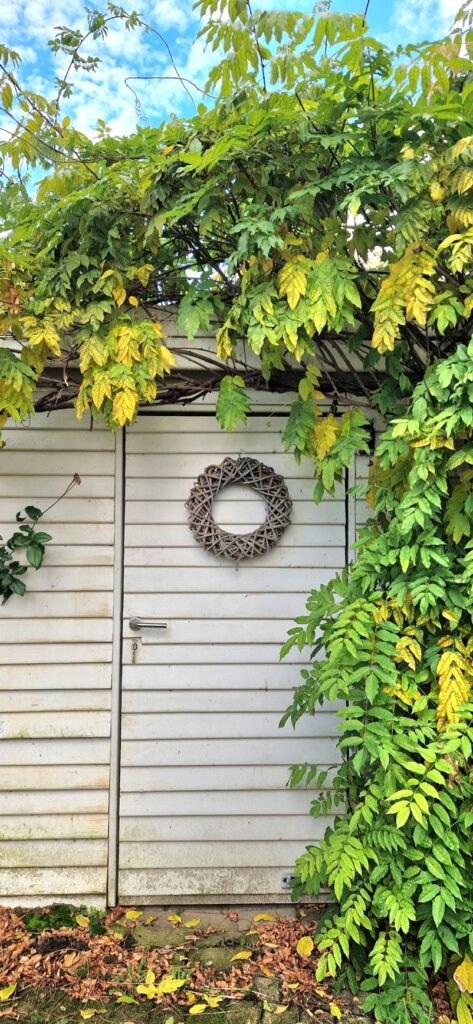
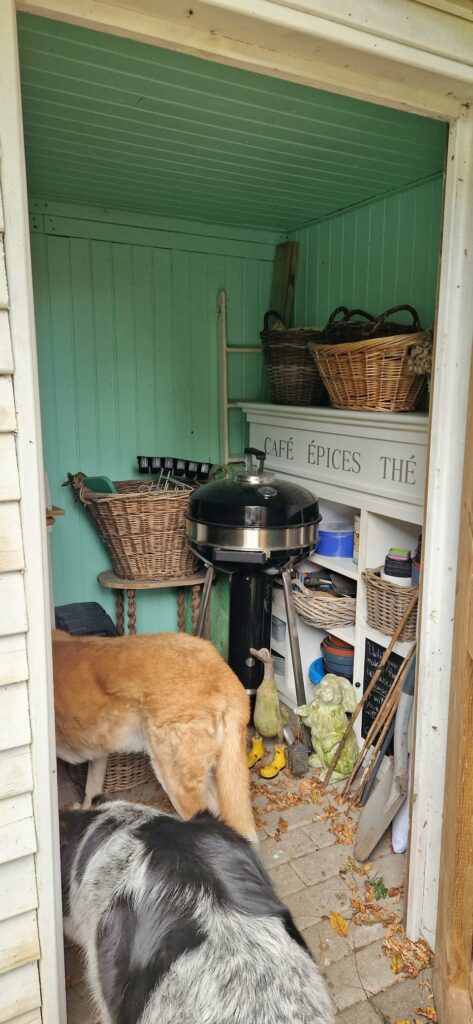
9. Store garden décor in the shed
Garden décor and small garden trinkets that are somewhat fragile, should be stored in a dry shed. Same goes for garden umbrellas and delicate garden furniture.
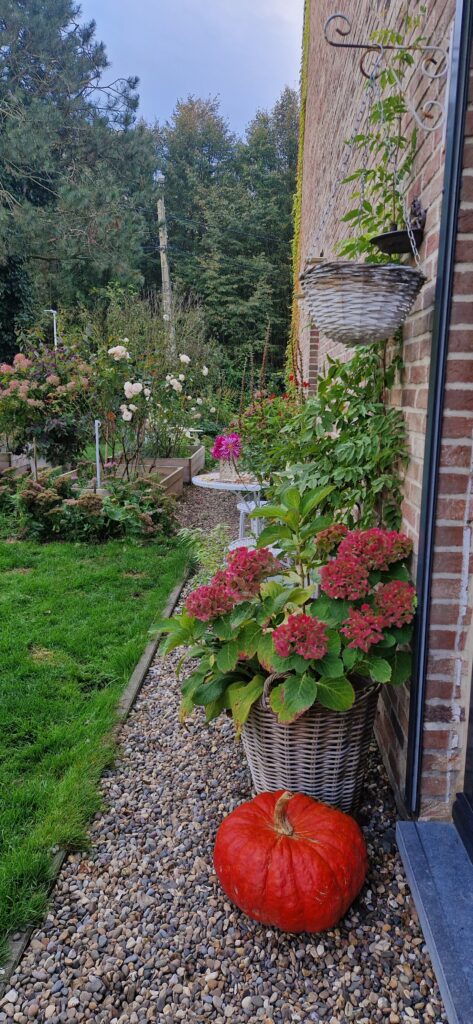
10. Plant trees, shrubs and other perennials
Autumn is the perfect time to plant new trees, shrubs and perennials. It is also the ideal time to divide plants. If a particular perennial or shrub didn’t thrive, maybe it’s time to relocate it and plant it somewhere else in the garden (think about light).
Trees, shrubs and perennials can be planted throughout Winter too but Autumn is a friendlier season to plant things because the soil isn’t frozen yet. In addition, it’s a lot more pleasant to work in the garden when temperatures are still relatively mild.
Planting in Autumn also gives plants time to grow their roots deep into the soil. This is especially important with dry Summers ahead.
11. Tidy up the vegetable garden and cover the raised beds
Make sure you harvest one last time before it starts freezing. If you grow kale like I do, you can harvest these throughout the colder months too since they aren’t fazed my a bit of frost and snow. I also continue to harvest hardier herbs like rosemary and thyme.

In addition, add some compost to your raised beds and cover them with fallen leaves. My beautiful Virginia Creeper turns into the most beautiful Autumnal colors before the leaves fall down. Once they fall down, I scoop them up and cover the raised beds and borders with them. This won’t only protect the soil, it will also feed it as it slowly decomposes.
12. Bring tender plants indoors
If you have tender plants growing in pots such as lemon trees or olive trees, either bring them inside or use frost covers to protect them from the freezing temperatures and wind.
I usually bring my lemon tree into the garage because we have plenty of natural light there. However, this year I’m thinking about leaving it outside and covering it like I do with my olive trees.
13. Clean and sharpen garden tools
Once you’ve finished doing your Autumn garden chores, give your tools a good clean with warm water and soap. Make sure they are clean and dry before you sharpen your secateurs.
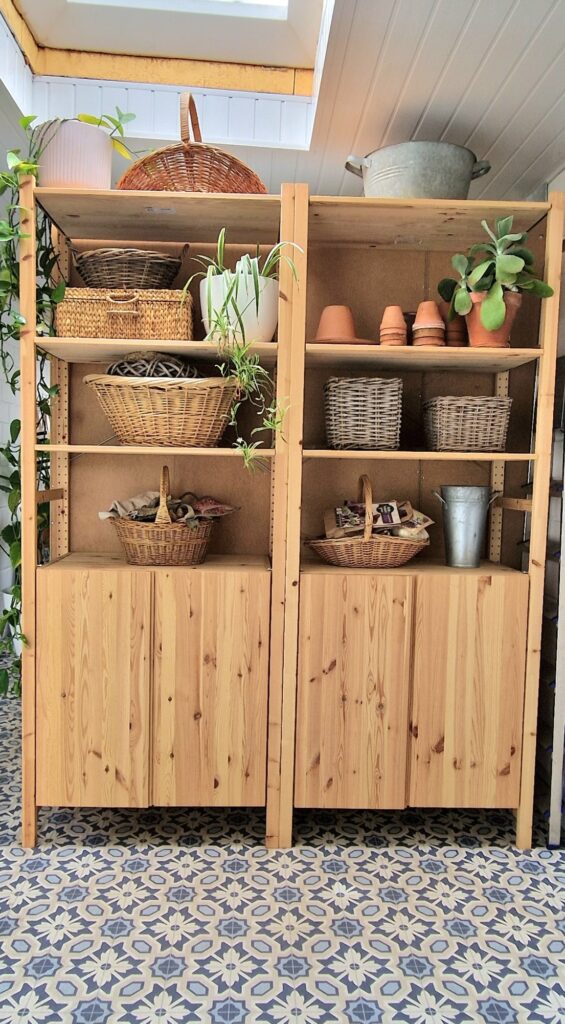
Once you are done cleaning and sharpening your tools, give them a coating of olive oil (don’t use your best and most expensive olive oil) and wrap them up in a cloth. Store your tools in a clean and dry space such as a shed or garage.
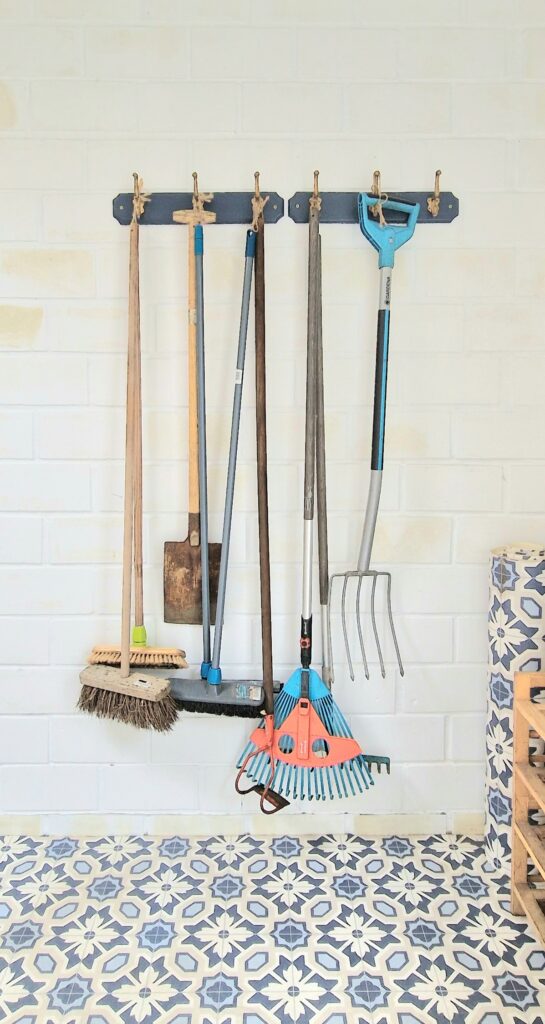
14. Have a meeting with the dogs!
Every gardener who lives with dogs, knows that dogs can be a bit of garden hooligans. Not just digging things up but also running through the borders, destroying plants by peeing on them or deciding to set up camp on your beautiful lavender beds... The list goes on.
So a meeting every now and then, is imperative! I also rarely leave them outside unattended and when it gets quiet, I know they are up to no good. Especially now that we seem to have an army of moles visiting our garden every Autumn. This makes the Chic Dogs even more determined to become hands-on in the garden.
I hope this blog post inspired you to go outside more often. Even if it’s just for 20 minutes each time. Your garden will be cared for and your brain and body will be healthier. Especially now that the days are short and daylight is scarce.
Love,
Wendy
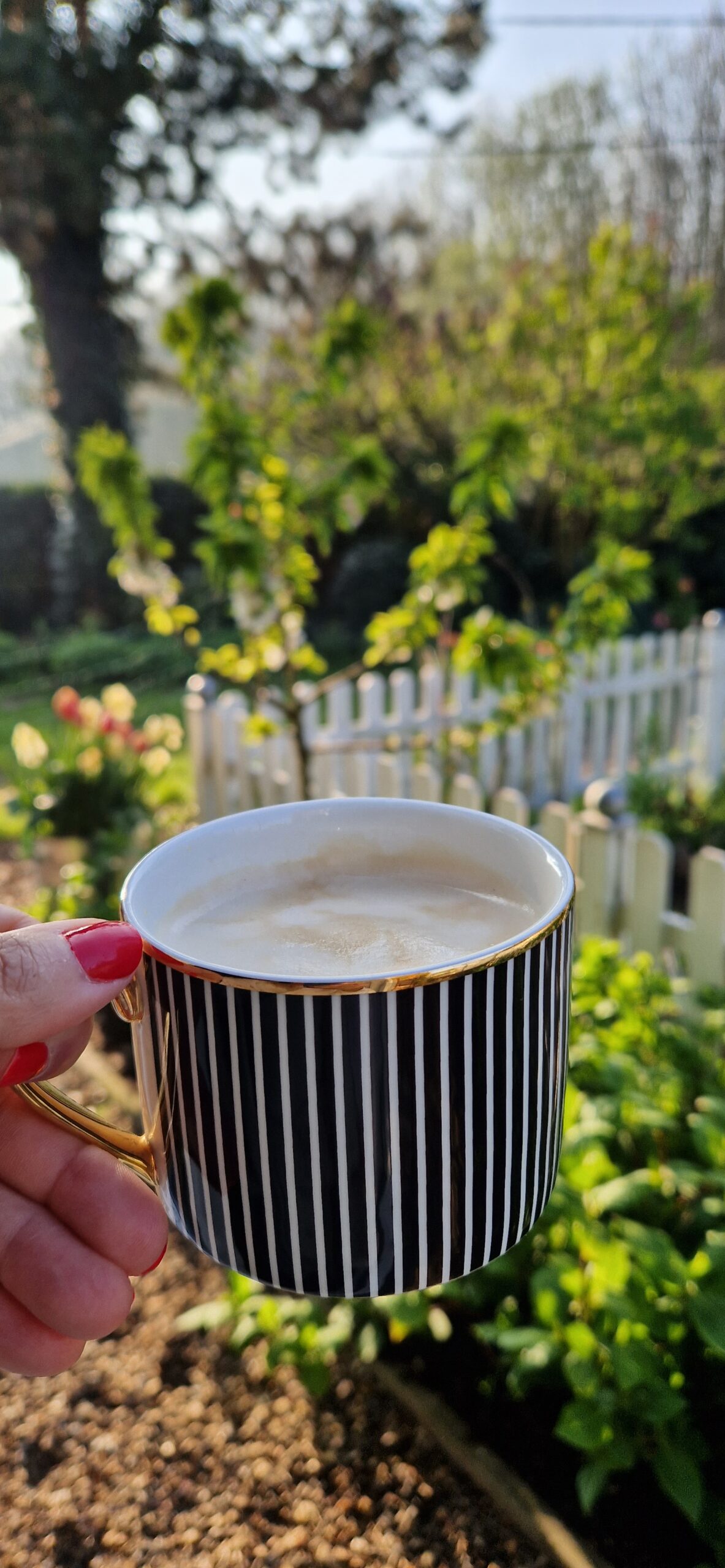
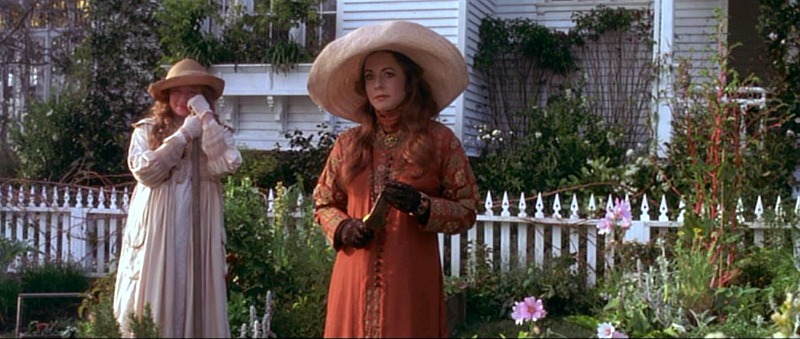
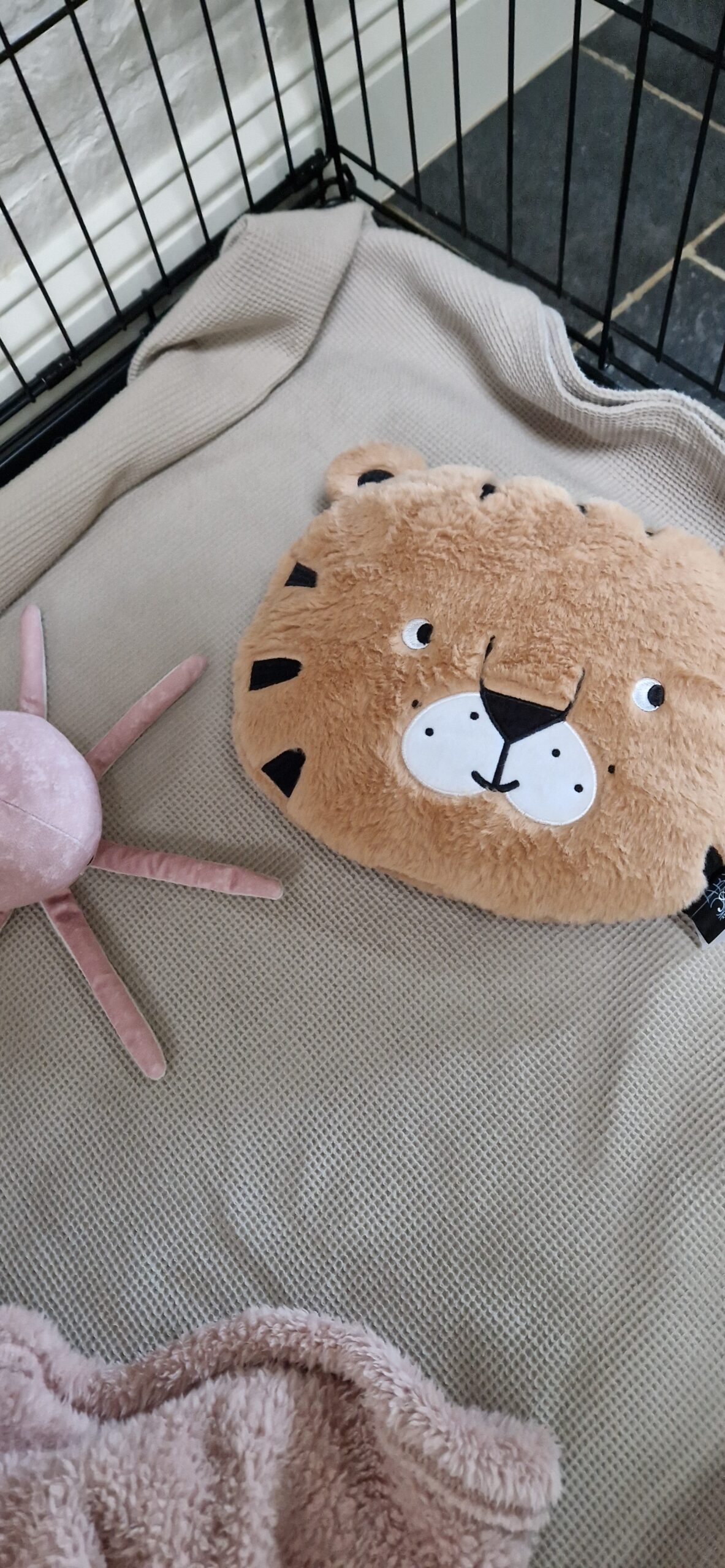
Leave a Reply